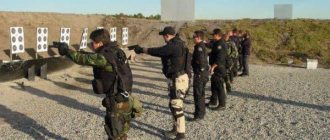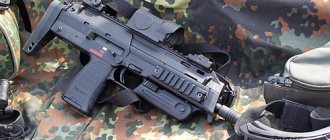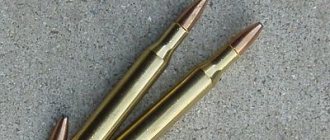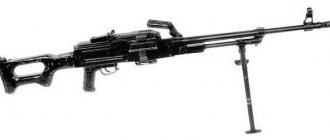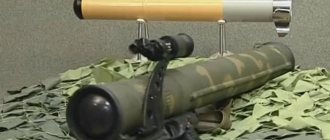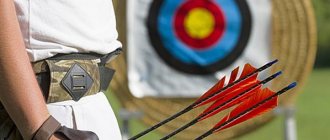Soviet closed-type cartridge SP-4
Closed-type cartridge
- a type of ammunition for small arms of small unmasking effect, which, as a rule, is developed for special operations[1]. Most of the samples of such cartridges adopted for service are based on the principle of expansion and cutting off powder gases in the variable-closed volume of the cartridge case and, because of this, allow flameless, silent and smokeless shooting without using a special silencer in the design of the weapon[1][2] [3].
Operating principle
As a rule, to cut off powder gases, a new part is introduced into the cartridge case - a piston, which is sometimes also called a wad or pan. It is placed between the powder charge and the bullet. When fired, under the pressure of burning gunpowder, the piston accelerates the bullet, and itself, jamming on the bevels of the cartridge case, ensures that the combustion products are locked inside it. After the shot, the excess pressure of the powder gases is gradually released through the gaps between the piston and the sleeve [2].
In such weapon systems (see, for example, TKB-506 or MSP), in order to reduce the loss of kinetic energy of the bullet due to friction, the length of the rifled part of the barrel does not exceed the length of the working stroke of the piston-pusher [2]; for the same purposes, the developers are also increasing the number of grooves from four to six[2]. The cartridge itself is usually equipped with a weighted bullet and a reduced charge of fast-burning powder[2]. As a result, the effective firing range for pistols does not exceed 25-50 meters, and for machine guns and rifles - 200-400 meters[2].
History of creation[edit | edit code]
SP-3 ammunition
appeared as a result of a set of works to modernize the SP-2 cartridge for the MSP two-shot pistol[2]. The main goal of modernization was to mislead about the very fact of using special weapons. To do this, the new silent ammunition was replaced with a standard bullet from the Soviet 7.62 × 39 mm machine gun cartridge of the 1943 model[2]. Despite all the efforts, the bullet of the created cartridge, after being fired, retained the signs of firing from a special weapon, since the barrel of the machine gun left traces of four rifling on it, and the pistol - six [2].
Interesting Facts
One of the first to try the idea of locking powder gases inside a weapon were the creators of the BraMit silencer, the Mitin brothers, who patented a “revolver for silent shooting” in 1929[3]. The revolver design they proposed had two coaxial drums, one of which contained bullets in special trays, and the second had holes for bullets to pass through when firing and special tray nests. During a shot, the bullet leaves the first drum together with the pan and, passing through the second, loses the pan, which, getting stuck in the pan socket, locks the powder gases inside the weapon. After the shot, when the combat drum rolls back to its original position, the already sufficiently cooled combustion products of the powder charge are released into the atmosphere [3]. With the next cocking of the hammer, both drums are simultaneously rotated by one slot, aligned coaxially with the barrel of the revolver[3]. Among the disadvantages of this system, difficulties with reloading are noted, since the shooter needed to remove not only spent cartridges from the first drum, but also the pallets that had settled in the sub-slots of the second [3].
Another interesting example of the first closed-type cartridges was the ammunition of the Soviet engineer Gurevich (Tula Arms Plant) with a liquid pusher, the action of which was based on the principle of a hydraulic gearbox [3] [4]. In the sleeve of its design, between the wad-piston and the bullet, there was distilled water, which, during the shot, pushed the bullet along the bore; at the same time, the wad, reaching the neck of the cartridge case, locked the powder gases inside it. The difference in cross-sectional area between the barrel and the sleeve provided a significant gain in speed due to the fact that water, unlike powder gases, is practically incompressible [3]. The disadvantage of this system was a large cloud of water spray that unmasked the shooter, as well as the inability to use this weapon at low temperatures, as a result of which the water froze and burst the cartridges [3] [4].
How silent ammunition and weapons were created
Sectional view of mufflers
While conventional weapons can be used to frighten or stop an enemy, silent weapons are almost always designed solely for killing.
Two main methods of combating the sound of a gunshot were invented and patented at the turn of the 19th-20th centuries, but the military and intelligence agencies became seriously interested in these inventions only before World War II.
How it works
The sound of a shot consists of several components: a shock (muzzle) wave created by hot gases escaping from the barrel along with the bullet; then the ballistic shock wave of the bullet itself if it flies faster than sound and, finally, the clang of moving weapon parts. But the main thing is the muzzle wave, so the two main methods of suppressing a shot involve weakening or eliminating it.
The first way is to reduce the pressure and cool the powder gases before they leave the barrel; the second is to lock them in the trunk altogether. In addition to this, it is proposed to use slow, subsonic bullets and use manual reloading if it is necessary to make the weapon as silent as possible.
The first principle - pressure reduction - is implemented in mufflers, when hot gases, before entering the atmosphere, expand and cool in the enclosed space of a special nozzle. As a rule, this is a hollow metal cylinder that is mounted on the muzzle of the barrel (sometimes it covers the entire length of the barrel), inside it there is one or more chambers for removing powder gases. These chambers are separated by partitions with holes or membranes made of soft materials like rubber, which prevent powder gases from “overtaking” the bullet. There may be special heat-absorbing elements inside the cylinder, such as metal shavings.
Soviet cartridges with powder gas cut-off
The second method - cutting off powder gases - involves the use of a complex of weapons and a special cartridge, usually with a sub-caliber bullet. A powder charge of reduced power is separated from the bullet by a wad-piston, which, when fired, accelerates the bullet, and then jams, resting against the slope of the cartridge case or against the protrusion of the barrel, locking the powder gases. The piston impulse is transmitted to the bullet directly or through a liquid, which accelerates the projectile down the barrel. This technique is more effective at eliminating sound, but makes weapons and ammunition too expensive and complex. In addition, gas shut-off cartridges are very difficult to use in automatic systems.
Silencers are simpler and cheaper, but they do not completely eliminate the sound of a shot - with most systems it resembles the pop of an air rifle or small-caliber rifle. Small silencers - now called tactical - simply “smear” the sound of a shot, making it difficult to detect the shooter. In addition, weapons equipped with such devices do not suppress their own, which simplifies the action of fighters in a group, especially indoors. Therefore, the Americans, for example, are actively promoting tactical silencers in their law enforcement agencies.
Maxim is not only a machine gun
It is believed that the first working model of the silencer was created in 1910 by the American Hiram Percy Maxim, the son of the creator of the famous machine gun. It is noteworthy that he made his development not for the army or special services, but for hunters - according to the inventor’s plan, the silencer would allow him not to spook the game in case of a miss or would help to shoot several animals in a row.
But already in the interwar period, designers from different countries actively experimented with silencers and systems that cut off powder gases in the interests of law enforcement agencies. True, most of the proposed solutions were not suitable for mass production or practical use.
Gurevich's experimental revolver
In the USSR, in 1929, brothers Vasily and Ivan Mitin received a patent for a revolver “for silent shooting” based on the Nagant system. The Mitins' revolver used cartridges with sub-caliber bullets, and the gap between the bullet and the cartridge case was filled by a cylindrical pan that acted as a piston. At the end of the barrel, an additional drum with chambers was mounted, which passed a small-caliber bullet, but jammed the pan, locking the powder gases in the barrel (after the shot, they were released through the gaps). The remaining pallets in the second drum were removed manually using a cleaning rod.
Experimental revolver of the Mitin brothers
Another invention using the principle of cutting off powder gases is Gurevich’s revolver and silent cartridges. The gunpowder in the cartridge case was covered with a steel wad, which was filled with paraffin, and distilled water was poured on top, and then the sleeve with the bullet was inserted. When fired, the steel wad squeezed out water, which accelerated the bullet in the barrel, and the wad itself became jammed inside the cartridge case. The weapon was tested, but it turned out to be not very reliable - there were ruptures in the cartridge case, the sleeve with the bullet falling out, and finally, the water could simply freeze in cold weather.
For partisans and saboteurs
The practical use of silencers began during World War II. In the Soviet Union, at the end of 1940, the Bramit muffler designed by Ivan Mitin was adopted (his brother Vasily Mitin was shot in 1937). Variants of the “Bramita” were designed for a revolver and for a Mosin rifle, but the first did not become widespread, as it greatly increased the dimensions of the weapon, reduced its power and accuracy. And “Bramit” for the “mosinka” was adopted for service in 1940 and was mass-produced from 1942.
Nagant revolver with Bramit silencer
The muffler was a cylinder about 15 centimeters long and a little more than three centimeters in diameter. It was used in combination with special cartridges of reduced power with a lightweight bullet (initial speed about 260 meters per second). The effective firing range did not exceed 200 meters.
Mosin rifle with Bramit silencer
In Britain, with the participation of members of the Special Operation Executive secret service (engaged in reconnaissance and organizing sabotage behind enemy lines), the Welrod silent pistol was developed. It was used by British intelligence officers and saboteurs, and was also supplied to resistance units in the territories of countries occupied by Germany.
Welrod pistol
The Welrod was a six- or eight-round pistol with manual reloading and an integrated multi-chamber silencer, inside of which there were metal partitions with rubber membranes. With each shot, the bullet pierced the membranes through, so the silencer was enough for about 15 shots - this was considered sufficient for one special operation.
Welrod pistol
The production of weapons began in 1942, and the British intelligence services continued to use them after the war. There are indications that the Welrod was used during the Western coalition operation against Iraq in 1991.
Submachine gun STEN Mk.IIS
Also for special operations behind enemy lines, the British made two models of low-noise submachine guns based on the famous STEN - STEN Mk.IIS and STEN Mk.VI. The first had a shortened barrel with an integrated multi-chamber silencer and was designed primarily for single shots, since automatic fire led to rapid wear of the silencer. The STEN Mk.VI used a silencer similar to the Mk.IIS, but the base model was an experimental model intended for arming paratroopers.
STEN Mk.VI
Tunnel Rat Pistol
A new stage in the design of silent weapons began in the 60s. One of the most famous Soviet designs is the Stechkin TKB-506A three-barrel shooting cigarette case, developed on instructions from the KGB. The weapon used silent cartridges developed by Igor Stechkin in the mid-50s based on the Makarov 9x18 pistol cartridge. By the way, these were the first Soviet cartridges with powder gas cut-off adopted for service. The effective firing range of the cigarette case did not exceed seven meters.
Cigarette case Stechkin TKB-506A
In the 60-70s, a whole series of silent weapons was created in the USSR, using the principle of cutting off powder gases: a double-barreled non-self-loading pistol C4 and the “Snake” cartridge (7.62x63 PZ) for it. Later, a modernized version of the S4M appeared chambered for PZA and PZAM cartridges. The development of the S4M was the silent pistol MSP "Groza" chambered for a special cartridge SP-3.
Pistol S4
For the GRU special forces and the KGB special forces in the 60s, two silent rifle-grenade launcher systems were created: Izdeliye D “Woodpecker” and Izdeliye DM “Storm”. Both systems used a nine-millimeter "Phalanx" armor-piercing cartridge and a "Mouthpiece" expelling cartridge to launch grenades (with a special attachment placed on the barrel). “Woodpecker” was a single-shot pistol, and “Storm” was a small carbine, where the magazine served as a pistol grip.
Cartridge "Phalanx"
In the period from 1979 to 1983, to arm KGB and military intelligence officers, the PSS Vul automatic silent pistol was created and adopted, using SP-4 gas cut-off cartridges.
Among the latest unusual developments, one can note the NRS-2 “Vzmakh” reconnaissance shooting knife chambered for the SP-4 cartridge.
The Americans were motivated to develop silent weapons by the Vietnam War. One of the leaders in this direction, the private company AAI in 1967 offered a whole line of silent weapons for special forces. The most famous was the silent shotgun QSPR (Quiet Special Purpose Revolver), which entered service with the troops in 1969 - it was used by “tunnel rats,” as the fighters who hunted partisans in tunnels were called.
QSPR revolver and cartridges for it
The silent revolver was created on the basis of the Smith & Wesson M29 in .44 Magnum caliber. Of course, the QSPR was not loaded with magnums, but with special cartridges, where a small powder charge was placed under a steel piston, which, when fired, pushed the projectile, and itself became wedged in the front of the cartridge case. The miracle revolver fired a projectile with 15 tungsten buckshots weighing 0.5 grams each. The initial speed of the buckshot was 220 meters per second, and the total power of the projectile was about 185 joules. A couple of shots at close range were enough to reliably hit the target.
Another interesting invention from AAI was a silent 12-gauge shotgun cartridge that could be used in any pump-action shotgun. Here, the powder gases were cut off by a glass made of thin steel, which was located between the charge and the pusher and was rigidly fastened to the cartridge case. When fired, this glass inflated like a balloon. A shotgun with a silent cartridge accelerated a 12-gram charge of buckshot to 140 meters per second. But the ammunition did not go into production due to its complexity and high cost.
MAC-10 Ingram submachine gun with silencer
In general, since the 70s of the last century in the United States, work on creating cartridges with cutoff of powder gases and weapons for them was curtailed. ATF officials insisted that each gas-cut cartridge itself could be considered a silent weapon, which meant that such ammunition should be accountable, serial numbered, and life-cycle tracked until scrapped. Too troublesome. As a result, the Americans preferred to use a weapon with a silencer chambered in a standard .45 ACP cartridge with a heavy subsonic bullet (velocity of about 270 meters per second).
The availability of 45-caliber ammunition allows you to train without regard to the cost of ammunition. And the ubiquity of the cartridge helps cover tracks: the discovery of a .45 ACP bullet or cartridge case at the scene of an operation is not evidence of a special operation, unlike the discovery of parts of a special cartridge.
Based on an article by Vladislav Grinkevich
Notes
- ↑ 1 2 Monetchikov S.
Special purpose cartridges // Bratishka: Monthly magazine of special purpose units. - M.: Vityaz-Bratishka LLC, 2012. - No. 08. - P. 26-29. - ↑ 1 2 3 4 5 6 Dick V.N.
Cartridges for special weapons // Explosives, gunpowder and ammunition of domestic production. - Minsk: Okhotkontrakt, 2009. - T. 1. - P. 89. - 280 p. — 1000 copies. — ISBN 978-985-6911-02-9. - ↑ 1 2 3 4 5 6 7 8 Ardashev A., Fedoseev S.
Russian whisper - a silent closed-type weapon (Russian) // “Weapons” magazine: special issue “Weapons of silent combat”. - 2002. - No. 07. - P. 53. - ISSN 1728-9203. - ↑ 1 2 Kirill Karasik.
Domestic silent weapons. Gurevich’s silent cartridge and weapons for him // Analytical portal “Military Review”: website. — 2012. — December 26. Archived from the original on March 6, 2020.


